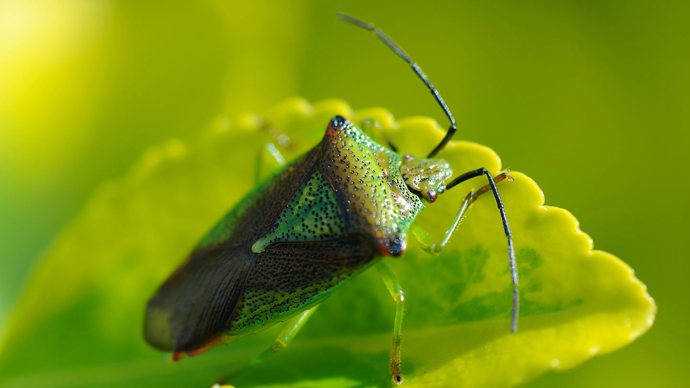Common name: hawthorn shieldbug
Scientific name: Acanthosoma haemorrhoidale
Family: Acanthosomatidae
Habitat: woodland, gardens, hedgerows, parks
Diet: hawthorn leaves and haws
Predators: birds
Origin: native
Leaf-munching minibeasts. The hawthorn shieldbug takes its name from the tree that it relies on for food.
Common name: hawthorn shieldbug
Scientific name: Acanthosoma haemorrhoidale
Family: Acanthosomatidae
Habitat: woodland, gardens, hedgerows, parks
Diet: hawthorn leaves and haws
Predators: birds
Origin: native
The hawthorn shieldbug is large, with a wingspan of 1.6cm, and is usually bright green although it can vary in colour. It is covered in lots of small black dots and has pointed ‘shoulders’ and red-brown wings.
Not to be confused with: the birch shieldbug, which is smaller and shorter, with a different pattern.

Credit: Amy Lewis / WTML
Hawthorn shieldbug nymphs feed on ripening haws, the fruit of the hawthorn tree. They also eat rowan and whitebeam berries.
Adults feed on hawthorn leaves, a habit that earned the species its name.
The female shieldbug lays her eggs during the spring, with them hatching in the summer. The nymphs mature in August and can be seen in areas close to their food plant.
Adult hawthorn shield bugs hibernate over winter.
Hawthorn shieldbugs are widespread across the UK and are usually found on hawthorn, as well as other trees such as hazel, rowan, birch and oak. It is commonly found in woodland, as well as parks and gardens.
Hawthorn shield bugs are drawn to bright lights, and can often turn up in moth traps.
Look out for the hawthorn shieldbug between May and October (though you won’t see new generation hawthorn shieldbugs until August or September). It’s one of the most commonly encountered shieldbugs in the UK so they’re likely to be around in gardens and woods that contain its shrubby food plants.
The hawthorn shieldbug is common across the UK, and is not currently considered to be under threat.


Amy Lewis • 14 May 2021
There are a number of shieldbug species in the UK, characterised by their flat, often triangular bodies and distinctive, shield-like shapes on their backs. Learn to tell which is which with our quick and easy guide to some of Britain's most familiar types.